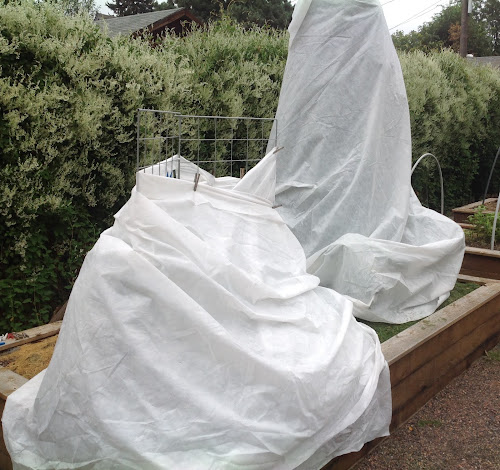"Then, all of a sudden, when you least expected it ... nighttime temperatures plunged to the 30s and it snowed, right smack dab near the end of a pretty good tomato and pepper year."
Sentiment expressed by gardeners everywhere!
As gardeners, we are more than aware of sudden weather related events all through the growing season. Snow over Mother's Day, yes, happens often, and guess what, a few hours after a warm Labor Day it's supposed to happen again.
The weather experts are predicting another weather whiplash with nights in the 30s plus snow overnight into September 8. The temperature drop in just a few hours will be sixty (give or take) degrees, yikes and oh darn - not good on our plants. They also say to expect the next four nights to be well below 40 degrees.
To give you some perspective, I did some checking on the last ten years and the dates our temperatures dropped to 40 and below in September. October can be similar and last October is proof, read here to jog your memory.
September 2018 we had six nights at 40 degrees and below starting on the 26th. October of that same near was cold too, nights stayed mostly in the low 40s to low 30s the entire month. That would have been a tough fall to extend the warm crop growing season.
September 2014 we had three nights from the 11th to 13th well below 40, the last night was down to 30 degrees.
September 2013 it wasn't until month's end like '18 when we hit the 30s at night - 27th through the 29th.
September 2011 we had high 30s on the 21st and 22nd.
All the other years in between held temperatures pretty well in the mid to high forties and fifties, not bad.
What does this mean for our warm-season crops? The list includes - tomato, pepper, eggplant, tomatillo, basil, squash, pumpkin, okra, corn, bean, cucumber, and melons. Ornamental annuals like petunia, geranium, lantana and many more. Plus, don't forget perennial plants that were just planted this spring, summer or very recently, they are not established, so they are vulnerable. In two words it means - not good. This group of plants may not survive well or at all if left unprotected. It is doubtful crops will continue to ripen, and remain healthy through this snap of cold temperatures.
What to do - if you are able, the day before or day of predicted cold, fully drape all warm loving crops, annuals and new plantings with some sort of cover.
It's also a very good idea to deeply water every plant in the landscape, believe it or not, moist plant roots weather cold snaps much better than dry roots. A wise landscape designer friend told me years ago that the ideal fall transition for landscape plants is one that gradually gets colder with plenty of rain to help them have wet feet (roots) headed into winter.
It is your choice. Cover your plants. Or don't.
Try to use light weight sheets or floating row covers and cloak the plants entirely, trapping in the warmth from the soil.
In the photo below, I wrapped two climbing bean plants. Notice how the cover goes all the way to the bottom of the plants, touching the raised bed cap. I should have (maybe I did later) used clothes pins to keep the flap from opening. These plants were right next to some Swiss chard which I knew would be fine in the cold. I used a heavy weight floating row cover which protects plants down to 28 degrees.
In the photo below I used an old electric blanket to cover a determinate tomato. I clipped the blanket edges to the cage. Ideally, the top should be covered to trap in warm air all around the plant.
A blanket isn't recommended when rain or snow are accompanied with the cold, unless you place a plastic tarp over the blanket to keep it dry. A light sheet or floating row cover is better since lighter fabric or frcover doesn't weigh down the plant when wet. Avoid using plastic directly over the plant, it just transfers cold to the foliage and fruit.
A good sized bucket or empty plant container over a recently planted plant should work just fine if it isn't in direct contact with the foliage.
Covering large and tall ornamental containers may need some posts, poles or sticks to support the size. The container below doesn't get direct rain or snow, so I just wrapped it with a light sheet and it held in place. An exposed container would need support to attach the material.
Below, I used a tomato cage over a geranium to hold the floating row cover in place, worked great!Be sure to uncover during the day when temperatures reach the 50s or at least high 40s. Dry out the cover materials and use them again the next night. This is tedious work, but you'll be rewarded with more vegetables in September and not having to replace recently planted perennials.
Hoop houses work great on smaller, shorter vegetable plantings or plantings through the garden. Just poke in the rebar and place the pvc pipe over the rebar to hold hoops in place. Clip on a floating row cover, light sheet or plastic as long as it doesn't touch the plants. Check out my Denver Post video here on building inexpensive hoop houses.
As insurance, I'm going to wrap the sprinkler pipes with an old blanket and cover the blanket with a plastic tarp or plastic. It's easy to do if you have the materials on hand.
I'm still shaking my head, I cannot believe it is going to be close to one hundred degrees tomorrow, September 5 and three days later snow and cold. Really!?








No comments:
Post a Comment
Note: Only a member of this blog may post a comment.